
| Carolina Panthers | |||
| Current season | |||
|
Established October 26, 1993 Play in and headquartered at Bank of America Stadium Charlotte, North Carolina |
|||
|
|||
| League/conference affiliations | |||
|
National Football League (1995–present) National Football Conference (1995–present) NFC West (1995–2001) NFC South (2002–present) |
|||
| Current uniform | |||
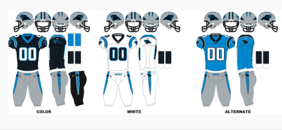 |
|||
| Team colors |
Black, Blue, Silver |
||
| Mascot | Sir Purr | ||
| Personnel | |||
| Owner(s) |
Jerry Richardson (48%) 14 others (52%)[1] |
||
| President | Danny Morrison | ||
| General manager | Dave Gettleman | ||
| Head coach | Ron Rivera | ||
| Team history | |||
| Carolina Panthers (1995–present) | |||
| Championships | |||
| League championships (0) | |||
|
Conference championships (1) NFC: 2003 |
|||
|
Division championships (3) NFC West: 1996 NFC South: 2003, 2008 |
|||
| Playoff appearances (4) | |||
| NFL: 1996, 2003, 2005, 2008 | |||
| Home fields | |||
|
Memorial Stadium (1995) Bank of America Stadium (1996–present) |
|||
The Carolina Panthers are a professional American football team representing the Carolinas. The Panthers are members of the Southern division of the National Football Conference (NFC) in theNational Football League (NFL). The team plays their games at Bank of America Stadium in Charlotte, North Carolina, which also serves as the team headquarters. The Panthers are one of the few teams in the NFL to own their stadium, legally registered as Panthers Stadium, LLC;[2] the team itself is legally registered as Panthers Football, LLC[3] and is worth approximately USD 1 billion according to Forbes. The Panthers uniforms consist of black, white, and blue jerseys, and white and silver pants, and have barely changed throughout their existence. The team maintains heated rivalries with all of their fellow NFC South teams, in particular the Atlanta Falcons and Tampa Bay Buccaneers, in addition to out-of-division rivalries with the Arizona Cardinals andDallas Cowboys.
The Carolina Panthers began play in 1995 and had success in their first several years, finishing 7-9 in 1995 (an all-time best for an expansion NFL team's first season) and 12-4 in 1996. Despite their early success, the Panthers would not have another winning season until 2003, when the team won the NFC and made it to Super Bowl XXXVIII, losing 32–29 to the New England Patriots. In their short history the Panthers have made the playoffs four times, reaching the NFC Championship Game in three of them. They have won three division titles, one in the NFC West and two in the NFC South. The team's most recent playoff appearance was in 2008, when the Panthers finished 12-4 before losing to the Arizona Cardinals in the divisional round. Since then the team has failed to record a winning season, with their 2012 season ending with a 7-9 record, a one-game improvement over their 6-10 finish in 2011.
Team history
Further information: History of the Carolina Panthers
On December 15, 1987, Jerry Richardson announced his bid for an NFL expansion franchise in the Carolinas.[4] Richardson, a former NFL player who had co-founded the Hardee's chain of restaurants and served as president and CEO of TW Services, had thought of the idea to pursue an NFL franchise after George Shinn successfully earned an NBA expansion team in Charlotte, the Charlotte Hornets. Richardson founded Richardson Sports, a partnership consisting of himself and his family; a number of businessmen from North and South Carolina were also recruited by Richardson to belimited partners in the group.[5] Richardson looked at four potential locations in the Carolinas for a stadium, ultimately choosing Uptown Charlotte. To help demonstrate demand for professional football in the Carolinas, Richardson Sports held a preseason game in the Carolinas each year from 1989 to 1991. The first two games wer held in Carter-Finley Stadium in Raleigh, North Carolinaand Kenan Memorial Stadium in Chapel Hill, North Carolina, respectively, while the third and final game was held at Williams-Brice Stadium in Columbia, South Carolina. In 1991, the group formally filed an application in 1991 for the open expansion bid, and on October 23, 1993, the 28 NFL owners unanimously awarded the Carolinas the 29th NFL franchise.[4]
The Panthers began play in 1995, their first season. The Panthers were one of two expansion teams accepted into the league that year, the other being the Jacksonville Jaguars. Led by head coachDom Capers, the team finished the season with a 7–9 record, the best from a first-year expansion team in league history.[6] They performed even better in their second season, finishing with a 12-4 regular season record in 1996 and winning the NFC West division.[7] The Panthers beat the Dallas Cowboys in the divisional round[8] before losing the NFC Championship Game to the eventualSuper Bowl champion Green Bay Packers.[9] The Panthers managed only a 7-9 finish in 1997 and slipped to 4-12 in 1998, leading to the firing of Capers as the team's head coach.[7] The Panthers hired former San Francisco 49ers coach George Seifert to replace Capers, and Seifert led the team to an 8-8 record in 1999, his first season. However, the Panthers finished 7-9 in 2000 and fell to 1-15 in 2001, winning their first game but losing their last 15. The Panthers fired Seifert after the season.[10]
The team hired New York Giants defensive coordinator John Fox to replace Capers,[11] and Fox led the team to a 7-9 finish in 2002. The Panthers defense was the second-best defense in the NFL in terms of yards conceded, but the team was hindered by an offense that ranked as the second-worst in the league in terms of yards gained.[12] The Panthers improved to 11-5 in the 2003 regular season, winning the NFC South[13] and making it to Super Bowl XXXVIII before losing to the New England Patriots 32–29 in what was immediately hailed by sportswriter Peter King as the "GreatestSuper Bowl of all time".[14] The Panthers finished 7-9 in 2004, a season where the team lost 14 players for the season due to injury.[A] Although the team started 1-7, they rebounded to win six of their last seven games. The team missed the playoffs, however, after losing their last game of the regular season to New Orleans. Had they won the game, the Panthers would have made the playoffs.[16] The Panthers improved to another 11-5 finish in 2005, finishing second in the division behind Tampa Bay but clinching a playoff berth.[17] The Panthers went on the road to face theNew York Giants, beating them 23–0 for the NFL's first playoff shutout against a home team since 1980.[18] They then beat Chicago 29–21 on the road the following week, but lost key playersJulius Peppers, a defensive end, and DeShaun Foster, a running back, due to injury.[19] The Panthers were defeated 34–14 in the NFC Championship Game, held in Seattle, by the Seattle Seahawks, ending the Panthers' season.[20] The Panthers went into the 2006 season as favorites to win the NFC South, but finished with a disappointing 8-8 record.[21] The team finished the 2007 season with a 7-9 record after losing quarterback Jake Delhomme early in the season due to an elbow injury.[22] In 2008, the Panthers recorded a 12-4 regular season record, winning the NFC South and securing a first-round bye. However, the Panthers were eliminated in the divisional round of the playoffs, losing 33-13 to the Arizona Cardinals after Delhomme turned the ball over six times.[23]Delhomme's struggles carried over into the 2009 season, where he threwing 18 interceptions through 11 games before breaking a finger in his throwing hand.[24] The Panthers were at a 4-7 record before Delhomme's season-ending injury and his backup, Matt Moore, led the team to a 4-1 finish to the season for an 8-8 overall record.[25]
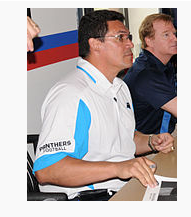
Current head coach Ron Rivera.
In 2010, sans Delhomme, the Panthers recorded the worst record in the league that season (2-14) and had the worst offense in the NFL during the season. John Fox's contract expired after the season ended and the Panthers did not retain him or his staff.[26] The Panthers hired Ron Rivera to replace Fox as head coach[27] and drafted Auburn quarterback Cam Newton with the first overall pick in the 2011 NFL Draft.[28] The Panthers opened the 2011 season 2-6, but finished the season with a 6-10 record,[27] and Newton was awarded the AP Offensive Rookie of the Year award after setting the NFL record for rushing touchdowns from a quarterback (14) and becoming the first NFL quarterback to throw for over 4,000 yards and rush for over 500 yards in a single season.[29] In 2012 the Panthers again opened the season 1-5. Longtime general managerMarty Hurney was fired due to this poor opening. The team slid to a 2-8 record before winning five of their last six games, resulting in a 7-9 record. This strong finish saved Rivera's job.[27]
Logo and uniforms

The Carolina Panthers' original logo, used from 1995 to 2011.
In choosing team name, the Richardsons did not run focus groups with potential fans. The Richardsons had always intended to name their team the 'Panthers' and did not hide this intention; Jerry Richardson had begun driving a car with the license plate 'PNTHRS' near the end of 1989. By the time they had been announced as the 29th NFL team, the Panthers' logo and helmet design had already been finalized, but the uniform design was still under creation. After discussion, the Panthers organization decided on jerseys colored white, black, and blue, and pants colored white and silver; the exact tone of blue, which they determined would be "process blue" (a shade lighter than Duke's and darker than North Carolina's), was the most difficult to determine. The team's uniform has rarely changed since their creation, and the changes that have been made are mostly minor ones, such as changing the sock color of the team's black uniforms from blue to black and changing the team's shoes from white to black.[30] Team owner Jerry Richardson, a self-described traditionalist, has said that no major uniform changes will be made in his lifetime;[31] the Panthers did, however, change their logo and logotype in 2012, the first such change in team history. According to the Panthers, the new logo was designed to modernize their old logo and give it a more "aggressive, contemporary look", as well as to give it a more three-dimensional feel.[32]
Carolina Panthers logotypes
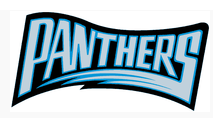
The team's first logomark, used in the 1995 season.

The team's second logomark, used from 1996 to 2011.

The current team logomark, which has been in use since 2012.
The Panthers have three main jersey colors: black, white, and blue.[33] Their blue uniforms, designated their alternate uniforms, are the newest, having been introduced in 2002.[34] The Panthers combined their regular black uniforms with black pants for the first time against the Denver Broncos in 2012, creating an all-black uniform, with the exception of blue socks and silver helmets. The decision to wear blue socks was made by team captain Steve Smith, who felt the blue socks gave the uniforms a more distinct appearance in comparison to other all-black uniforms.[35] The team's uniform did not change much after Nike became the NFL's jersey suppliers in 2012, but the collar of the uniforms was altered to honor former Panthers player and coach Sam Mills by featuring the phrase "Keep Pounding". Nike had presented this idea to the Panthers organization, who approved it; the team appreciated this idea, as they wanted newer fans to gain a greater understanding of the legacy Mills, who died of cancer of 2005, left behind. Mills had introduced the phrase, which has since become a team slogan, in a speech to the team prior to their 2003 playoff game against Dallas; in the speech, Mills reconciled his fight against cancer with the team's on-field battle, saying "When I found out I had cancer, there were two things I could do – quit or keep pounding. I’m a fighter. I kept pounding. You’re fighters, too. Keep pounding!".[36]
Stadium and practice facilities
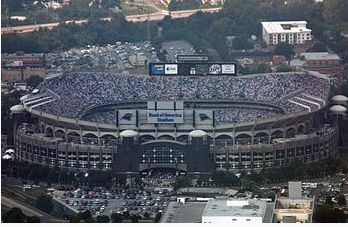
An exterior view of Bank of America Stadium. Bank of America Stadium is located in uptown Charlotte and can seat over 73,000 people.
In their first year of play, the Panthers played at Memorial Stadium in Clemson, South Carolina, as the Panthers stadium in uptown Charlotte was still under construction. Ericsson Stadium, now called Bank of America Stadium, opened in summer 1996. The stadium was privately financed by the Panthers,[4]with the Panthers paying $248 million dollars for the stadium construction and Charlotte paying $60 million for "land and infrastructure developments".[37] In February 2013, the city of Charlotte tentatively agreed to give the Panthers $143.75 million dollars over a 15-year period to help fund a $250 million dollar renovation of Bank of America Stadium. This deal requires the Panthers remain in Charlotte for the 15 years, and would be funded by a 1 percent increase in Charlotte's food and beverage tax. The team plans to use the money to, among other things, build escalators to help fans reach the stadium's upper deck as well as to improve the stadium's video boards.[38]
Bank of America Stadium is owned entirely by the Panthers, making them one of the few teams in the NFL to own their stadium.[39] The stadium was specially designed by HOK Sports Facilities Group for football and has a seating capacity of 73,778; it also serves as the headquarters and administrative office for the Panthers. It offers public tours for ten people or less on Wednesdays and Fridays as well as group tours for 11-100 people from Monday to Friday, charging a fee for either type.[40] Six bronze panther statues flank the stadium's three main entrances — according to the Panthers, they are the largest statues ever commissioned in the United States.[4] The names of the team's original permanent seat licence (PSL) owners are engraved on the base of each statue. The two people in the Panthers Hall of Honor, team executive Mike McCormack and linebacker Sam Mills, are both honored with life-sized bronze statues outside the stadium.[41]
In addition to hosting Panthers home games, Bank of America stadium has hosted other events. It annually hosts two college football games, the ACC Championship Game[42] and the Belk Bowl.[43] The stadium has also hosted international soccer friendlies, the NCAA Men's College Cup,[44] and concerts. It was intended to host the final night of the 2012 Democratic National Convention, but the event was moved to nearby Time Warner Cable Arena instead, due to concerns of stormy weather.[45]
During the team's 1995 season, the team practiced at Winthrop University in Rock Hill, South Carolina.[46] The Panthers have three[47] open-air practice fields next to Bank of America stadium. Because they, along with the stadium, are located in uptown Charlotte, the fields are directly visible from skyscrapers as well as from a four-story condominium located across the street. A running joke said that the Panthers' division rivals had pooled their resources to purchase a room on the building's top floor, and that a fire at the condominium was caused by the Panthers organization. In order to prevent people from seeing inside the field while the team is practicing, the team has added "strategically planted trees and a tarp over the... fence surrounding the fields". Additionally, they employ a security team to watch and chase away any people that stop alongside the fence surrounding the field.[48] In the event of bad weather, the team relocates their practices to an indoor sports facility about 10 miles from the stadium. The team does not own this facility.[49] The team has hosted training camp at Wofford College in Spartanburg, South Carolina since 1995.[50]
Culture
Pat Yasinskas of ESPN.com observed that while there is "a bit of a wine-and-cheese atmosphere at Panthers games... there is a strong core of diehard fans who bring energy to Bank of America Stadium. Charlotte lives and dies with the Panthers because there aren't a lot of other options in the sports world".[51] In 2004, NPR reporter Scott Jagow observed that the Panthers' Super Bowl appearance in 2004 represented the arrival of Charlotte onto the national scene, despite the crowd's "wine and cheese" reputation.[52] The Panthers are also supported in South Carolina; Nikki Haley, the Governor of South Carolina, declared July 30, 2012, "Carolina Panthers Day" in South Carolina, saying that "when it comes to professional teams, the Carolina Panthers are the team that South Carolina calls their own".[46]Sports Illustrated graded the Panthers as having the tenth-highest "NFL Fan Value Experience", attributing much of the fan atmosphere to the team's newness when compared to the established basketball fanbase. They noted that while visiting fans often outnumber Panthers fans at home games, this is partially because many of Charlotte's residents are "transplants... from NYC,Philly, [and] Atlanta". They also observed that the stadium has scattered parking lots, each of which has a different tailgating style. Some have fried chicken, pork, or Carolina-style barbecue, while others have live bands and televisions. Pickup football games in the parking lots are common, but fans tend to "behave themselves", in part due to blue laws that prevent the sale of alcohol before noon on Sundays.[53]
Mascot, cheerleaders, and drumline
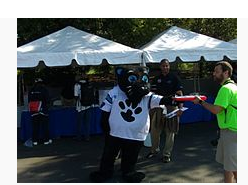
Panthers mascot Sir Purr, wearing a white jersey.
Since their first season, the mascot of the Carolina Panthers has been Sir Purr, an anthropomorphic black cat who wears a jersey numbered '00'. During games, Sir Purr provides sideline entertainment through skits and "silly antics".[54] Sir Purr participates in a number of community events year-round, including a monthly visit to the patients at Levine Children's Hospital in Carolinas Medical Center. Additionally, Sir Purr hosts the annual 'Mascot Bowl' game, a halftime event which pits pro and college mascots against each other in a tackle football game.[55]
The team's cheerleaders are the Carolina Topcats, a group of 24 women who cheer on the team and entertain fans at home games. The TopCats participate in both corporate and charity events.[56] The team'sdrumline is PerrCussion, an ensemble of snare, tenor, and bass drummers as well as cymbal players. PerrCussionpeform for fans outside the stadium and introduce players prior to the game, and consists of drummers from across the Carolinas.[57]
Radio and television
Carolina Panthers games are broadcast through flagship station WBT (1110 AM) and through the Carolina Panthers Radio Network. The team's radio network gives pre-game coverage, in-game commentary of games, and post-game wrap-ups in addition to Panther Talk, a live event held at Bank of America Stadium each Monday (or Tuesday if the Panthers have a Monday night game) from 8:05-9:00 PM during the regular season. Panther Talk is hosted by the Panthers broadcasting team of Mick Mixon, Jim Szoke, and Eugene Robinson and features head coach Ron Rivera as well as a player guest. The event is open to the public and aired live on the Panthers radio network, and fans can ask the head coach questions as well as get autographs from the player.[58] From 1995-2004, Bill Rosinski served as the team's play-by-play announcer. Rosinski was fired in 2005 and replaced by Mixon.[59] In a public statement, the Carolina Panthers said they fired Rosinski to "go in a different direction", but Rosinski asserts that he was fired because a comment he had made in an article, saying the most disappointing part of his career with the Panthers was not getting an NFC Championship ring, "obviously stuck in someone's craw".[60] The Panthers also have a television network, the Carolina Panthers Television Network, originating from flagship station Fox Charlotte WCCB-TV. The network covers preseason games that are not nationally televised with play-by-play commentator, Mike Morgan, color commentator Mike Rucker, and sideline reporter Pete Yanity. The television network also hosts Panthers Huddle, a weekly show focusing on the Panthers' upcoming opponent. Panthers Gameday (hosted by Greg Bailey and former Panthers safety Mike Minter), the Panthers' postgame show, is hosted on News Channel 36.[61]
Radio and television affiliates
Carolina Panthers games are broadcast on radio throughout North and South Carolina as well as in portions of Virginia and Georgia. Games are broadcast through local television in all major North and South Carolina markets as well as in areas of Virginia, Georgia, and Tennessee. Affiliates are listed below.
| List of radio affiliates[58] | ||
| [show]City | Call sign | Frequency |
Rivalries
Main articles: Buccaneers–Panthers rivalry and Falcons–Panthers rivalry
The Panthers have developed a number of rivalries during their time in the NFL. The Panthers maintain heated rivalries with each of their fellow NFC South members.[62][63] In particular, the team's biggest rivals are the Atlanta Falcons[64]and the Tampa Bay Buccaneers.[62] The Falcons are a natural geographic rival for the Panthers, as Atlanta is located 230 miles (370 kilometers) south on I-85.[62] The Panthers rivalry with Tampa Bay is perhaps the most intense rivalry in the NFC South; the rivalry began heating up in 2003 when Panthers defensive tackle Brentson Buckner declared fellow Panther Kris Jenkins the best interior lineman in the NFL as opposed to Tampa's Warren Sapp. The rivalry became more intense when the Panthers beat Tampa Bay in overtime in what ESPN.com writer Pat Yaskinskas described as "one of the most physical contests in recent memory". Due to the intensity of the rivalry, several players have suffered severe injuries. Buccaneers quarterback Chris Simms ruptured his spleen after being hit front and back by two Panthers players. Panthers defensive tackle Kavika Pittman suffering a career-ending injury on a block; some of his teammates alleged the hit was cheap play.[65] In one of the dirtier plays of the series, Panthers cornerback Dante Wesley illegally hit Tampa's punt returner Clifton Smith in the throat before Smith had even caught the ball. This resulted in Wesley being ejected from the game, and also sparked a brief melee between the two teams.[66]
Outside the division, the Panthers have several other rivals. During their time in the NFC West, the Panthers began developing a rivalry with the San Francisco 49ers. However, this rivalry faded after the NFL moved the Panthers out of the NFC West.[67] The Panthers maintain rivalries with the Arizona Cardinals and Dallas Cowboys, both of whom the Panthers have played frequently.[68][69]
Pro Bowlers
The Pro Bowl is the annual all-star game of the NFL. Pro Bowl rosters are determined by a combination of fan, player, and coach voting.
| Carolina Panthers Pro Bowlers[71] | ||||
| Player | Position | Year | ||
| Michael Bates | KR | 1996 | ||
| Kerry Collins | QB | |||
| Eric Davis | CB | |||
| Kevin Greene | LB | |||
| John Kasay | K | |||
| Lamar Lathon | LB | |||
| Sam Mills | LB | |||
| Wesley Walls | TE | |||
| Michael Bates (2) | KR | 1997 | ||
| Wesley Walls (2) | TE | |||
| Michael Bates (3) | KR | 1998 | ||
| Kevin Greene (2) | LB | |||
| Wesley Walls (3) | TE | |||
| Michael Bates (4) | KR | 1999 | ||
| Steve Beuerlein | QB | |||
| Muhsin Muhammad | WR | |||
| Wesley Walls (4) | TE | |||
| Michael Bates (5) | KR | 2000 | ||
| Todd Sauerbrun | P | 2001 | ||
| Steve Smith | KR | |||
| Wesley Walls (5) | TE | |||
| Kris Jenkins | DT | 2002 | ||
| Todd Sauerbrun (2) | P | |||
| Stephen Davis | RB | 2003 | ||
| Kris Jenkins (2) | DT | |||
| Mike Rucker | DE | |||
| Todd Sauerbrun (3) | P | |||
| Mark Fields | LB | 2004 | ||
| Dan Morgan | LB | |||
| Muhsin Muhammad (2) | WR | |||
| Julius Peppers | DE | |||
| Jake Delhomme | QB | 2005 | ||
| Julius Peppers (2) | DE | |||
| Steve Smith (2) | WR | |||
| Mike Wahle | G | |||
| Kris Jenkins (3) | DT | 2006 | ||
| Julius Peppers (3) | DE | |||
| Steve Smith (3) | WR | |||
| Jon Beason | LB | 2008 | ||
| Jordan Gross | T | |||
| Julius Peppers (4) | DE | |||
| Steve Smith (4) | WR | |||
| Jon Beason (2) | LB | 2009 | ||
| Ryan Kalil | C | |||
| Julius Peppers (5) | DE | |||
| DeAngelo Williams | RB | |||
| Jon Beason (3) | LB | 2010 | ||
| Jordan Gross (2) | T | |||
| Ryan Kalil (2) | C | |||
| Ryan Kalil (3) | C | 2011 | ||
| Cam Newton | QB | |||
| Steve Smith (5) | WR | |||
Hall of Honor
The Carolina Panthers Hall of Honor was established in 1997 to honor individuals for their contributions to the Carolina Panthers organization. Each inductee is honored with a life-sized bronze statue outside of Bank of America Stadium's North Entrance, while the names of each original PSL owner are written on the black granite base at each of the six Panther statues.[41] A rule added in the mid-2000s by the Panthers organization requires all potential inductees to have been retired for at least five years before being eligible for induction.[72]
| Carolina Panthers Hall of Honor | ||||
| N° | Player | Position | Tenure | Inducted |
| n/a | Mike McCormack |
Executive Consultant General Manager Team President |
1989-1997 | September 21, 1997 |
| 51† | Sam Mills |
Leader Gentleman Linebacker |
1995-1997 | September 27, 1998 |
| n/a | PSL Owners | n/a | n/a | September 13, 2004 |
| † denotes retired number | ||||
Pro Football Hall of Fame enshrinees
Nominees for the Pro Football Hall of Fame, which "honor[s] individuals who have made outstanding contributions to professional football";,[73] are determined by a 46-member selection committee. At least 80% of voters must approve the nominee for him to be inducted.[74]
| Carolina Panthers Hall of Fame enshrinees[75] | ||||
| N° | Player | Position | Tenure | Inducted |
| 92 | Reggie White | Defensive end | 2000 | 2006 |
Ownership and administration
Jerry Richardson is the owner and founder of the Carolina Panthers.[1] Richardson and his family own about 48% of the team,[B] with the remaining 52% owned by a group of 14 partners;[30] Richardson paid $206 million for the team in 1993; according to Forbes, the Panthers are worth approximately $1 billion as of 2012. They ranked the Carolina Panthers as the sixteenth-most valuable NFL team[77] and the twenty-third most valuable sports team in the world.[78]
Mike McCormack, a Hall of Fame lineman for the Cleveland Browns and former coach and executive for the Seattle Seahawks, was the Panthers' first team president, presiding in that role from 1994-1997. McCormack retired from the position in 1997 and was inducted as the first person in the Carolina Panthers Hall of Honor later that year.[4] Jerry Richardson's son, Mark Richardson, was appointed as the team's second president in 1997 and served in that role until his resignation in 2009. Richardson's resignation was simultaneous with that of his brother Jon, who had been president of Bank of America Stadium. The resignations of Mark and Jon Richardson were considered unexpected moves as they had been expected to eventually take over the team from their father.[79] Mark Richardson was replaced by Danny Morrison, who had previously served as the athletic director at Texas Christian University.[80]
The Carolina Panthers have had four head coaches. Dom Capers was the head coach from 1995 to 1998, and led the team to one playoff appearance. Counting playoff games, he finished with a record of 31-35 (.470). George Seifert coached the team from 1999 to 2001, recording 16 wins and 32 losses (.333). John Fox, the team's longest-tenured head coach, led the team from 2002 to 2010 and coaches the team to three playoff appearances. Including the playoffs, he ended his tenure with a 78-74 (.513) record. Ron Rivera, the team's current head coach, had held the position since 2011 and has a career record of 13 wins and 19 losses (.406).[81]
Team records
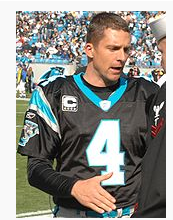
Kicker John Kasay, the team's career leader in scoring. Kasay spent 16 seasons with Panthers, from 1995–2010, and became a fan favorite during his tenure with the team.[82]
Since beginning play in 1995, the Panthers have been to three NFC Championship Games; they lost two (1996 and 2005) and won one (2003).[12][83] The Panthers have won three division championships: the NFC West championship in 1996 and the NFC South championships in 2003 and 2008. They have finished as runners-up in their division six times, finishing second-place in the NFC West in 1997 and 1999 and finishing second-place in the NFC South in 2005, 2006, 2007, and 2012.[84][85] They have qualified for the playoffs four times, most recently in 2008.[12]
Kicker John Kasay is the team's career points leader. Kasay scored 1,482 points during his 16 seasons (1995 to 2010) with the Panthers. Quarterback Jake Delhomme, who played with the team from 2003 to 2009, is the career passing leading, having thrown for 19,258 yards over his seven seasons with the team.[86] Running back DeAngelo Williams is the career rushing leader for the Carolina Panthers. Williams, who has played with the team since being drafted in 2006, has rushed for 5,784 yards with the Panthers.[86] Wide receiver Steve Smith, the team's leading receiver, has recorded 11,452 receiving yards during his 11-year (2001 to present) tenure with the team.[86]




















